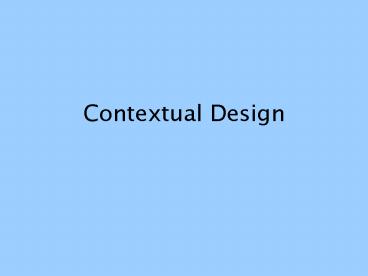Contextual Design PowerPoint PPT Presentation
Title: Contextual Design
1
Contextual Design
2
Purpose for us
- An example
- A term often used, with varying levels of
precision
3
Purpose of CI
- Translate ethnographic methods to more procedural
methodology - A group can learn together
- Structures group processes
- Takes less time
4
Focus on intentions
- Intentions purposes for accomplishing a task,
apart from means - explicit or implicit
- often a cascade of intentions
- highest level change little over time
- collection of lower-level strategy for
attaining higher level
5
Contextual Design Steps
- Contextual inquiry field interviews and
observations at work site - Work Modeling captures the work of
indidividuals and organizations - Consolidation brings data from individual
customer interviews together so the team can see
common pattern and structure without losing
individual variation. - Work redesign to improve work by using
technology to help people do their work - Storyboards how people will work with the new
system - User environment design -- the floor plan of
the new system - Prototyping
- Prioritization and object-oriented design
6
Work Modeling
- captures the work of individuals and
organizations - flow model communication and coordination,
- cultural model culture and policy,
- sequence model detailed steps to accomplish a
task, - physical model physical environment as it
supports the work, - artifact model how artifacts are used and
structured in work.
7
Consolidation
- brings data from individual customer interviews
together so the team can see common pattern and
structure without losing individual variation. - The affinity diagram brings together issues and
insights across all customers into a wall-sized,
hierarchical diagram to reveal the scope of the
problem. - Consolidated work models bring together each
different type of work model separately, to
reveal common strategies and intents while
retaining and organizing individual differences.
PowerShow.com is a leading presentation sharing website. It has millions of presentations already uploaded and available with 1,000s more being uploaded by its users every day. Whatever your area of interest, here you’ll be able to find and view presentations you’ll love and possibly download. And, best of all, it is completely free and easy to use.
You might even have a presentation you’d like to share with others. If so, just upload it to PowerShow.com. We’ll convert it to an HTML5 slideshow that includes all the media types you’ve already added: audio, video, music, pictures, animations and transition effects. Then you can share it with your target audience as well as PowerShow.com’s millions of monthly visitors. And, again, it’s all free.
About the Developers
PowerShow.com is brought to you by CrystalGraphics, the award-winning developer and market-leading publisher of rich-media enhancement products for presentations. Our product offerings include millions of PowerPoint templates, diagrams, animated 3D characters and more.

